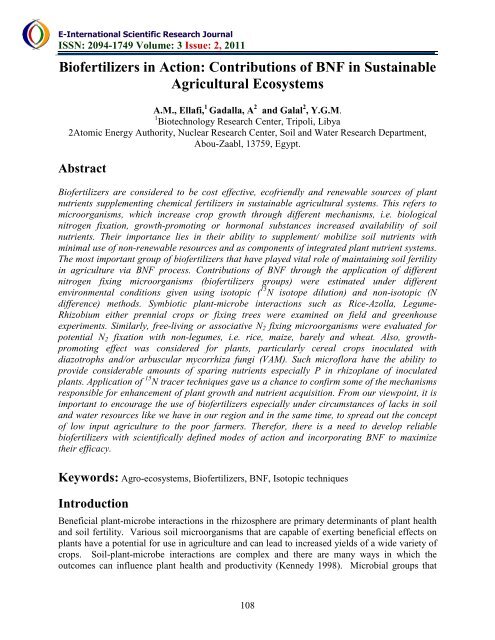download the full article here - E-International Scientific Research ...
download the full article here - E-International Scientific Research ...
download the full article here - E-International Scientific Research ...
You also want an ePaper? Increase the reach of your titles
YUMPU automatically turns print PDFs into web optimized ePapers that Google loves.
E-<strong>International</strong> <strong>Scientific</strong> <strong>Research</strong> Journal<br />
ISSN: 2094-1749 Volume: 3 Issue: 2, 2011<br />
Biofertilizers in Action: Contributions of BNF in Sustainable<br />
Agricultural Ecosystems<br />
A.M., Ellafi, 1 Gadalla, A 2 and Galal 2 , Y.G.M.<br />
1 Biotechnology <strong>Research</strong> Center, Tripoli, Libya<br />
2Atomic Energy Authority, Nuclear <strong>Research</strong> Center, Soil and Water <strong>Research</strong> Department,<br />
Abou-Zaabl, 13759, Egypt.<br />
Abstract<br />
Biofertilizers are considered to be cost effective, ecofriendly and renewable sources of plant<br />
nutrients supplementing chemical fertilizers in sustainable agricultural systems. This refers to<br />
microorganisms, which increase crop growth through different mechanisms, i.e. biological<br />
nitrogen fixation, growth-promoting or hormonal substances increased availability of soil<br />
nutrients. Their importance lies in <strong>the</strong>ir ability to supplement/ mobilize soil nutrients with<br />
minimal use of non-renewable resources and as components of integrated plant nutrient systems.<br />
The most important group of biofertilizers that have played vital role of maintaining soil fertility<br />
in agriculture via BNF process. Contributions of BNF through <strong>the</strong> application of different<br />
nitrogen fixing microorganisms (biofertilizers groups) were estimated under different<br />
environmental conditions given using isotopic ( 15 N isotope dilution) and non-isotopic (N<br />
difference) methods. Symbiotic plant-microbe interactions such as Rice-Azolla, Legume-<br />
Rhizobium ei<strong>the</strong>r prennial crops or fixing trees were examined on field and greenhouse<br />
experiments. Similarly, free-living or associative N 2 fixing microorganisms were evaluated for<br />
potential N 2 fixation with non-legumes, i.e. rice, maize, barely and wheat. Also, growthpromoting<br />
effect was considered for plants, particularly cereal crops inoculated with<br />
diazotrophs and/or arbuscular mycorrhiza fungi (VAM). Such microflora have <strong>the</strong> ability to<br />
provide considerable amounts of sparing nutrients especially P in rhizoplane of inoculated<br />
plants. Application of 15 N tracer techniques gave us a chance to confirm some of <strong>the</strong> mechanisms<br />
responsible for enhancement of plant growth and nutrient acquisition. From our viewpoint, it is<br />
important to encourage <strong>the</strong> use of biofertilizers especially under circumstances of lacks in soil<br />
and water resources like we have in our region and in <strong>the</strong> same time, to spread out <strong>the</strong> concept<br />
of low input agriculture to <strong>the</strong> poor farmers. T<strong>here</strong>for, <strong>the</strong>re is a need to develop reliable<br />
biofertilizers with scientifically defined modes of action and incorporating BNF to maximize<br />
<strong>the</strong>ir efficacy.<br />
Keywords: Agro-ecosystems, Biofertilizers, BNF, Isotopic techniques<br />
Introduction<br />
Beneficial plant-microbe interactions in <strong>the</strong> rhizosp<strong>here</strong> are primary determinants of plant health<br />
and soil fertility. Various soil microorganisms that are capable of exerting beneficial effects on<br />
plants have a potential for use in agriculture and can lead to increased yields of a wide variety of<br />
crops. Soil-plant-microbe interactions are complex and <strong>the</strong>re are many ways in which <strong>the</strong><br />
outcomes can influence plant health and productivity (Kennedy 1998). Microbial groups that<br />
108

















